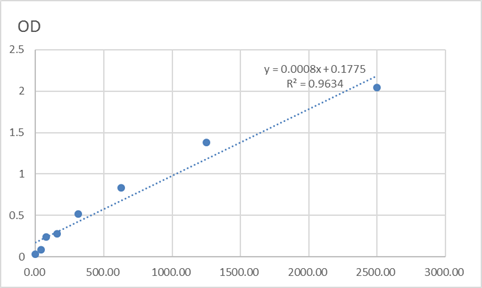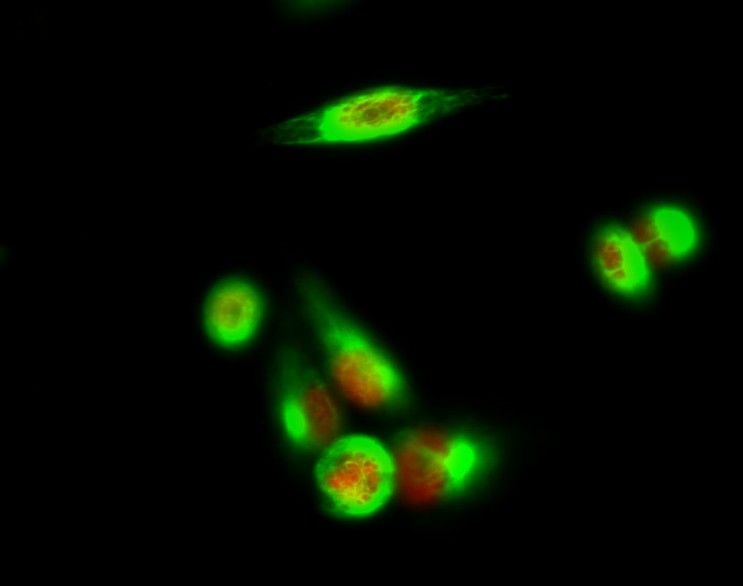Total p35 Cell-Based Colorimetric ELISA Kit
- Catalog No.:KA3741C
- Applications:ELISA
- Reactivity:Human;Mouse;Rat
- Gene Name:
- CDK5R1
- Human Gene Id:
- 8851
- Human Swiss Prot No:
- Q15078
- Mouse Swiss Prot No:
- P61809
- Rat Swiss Prot No:
- P61810
- Storage Stability:
- 2-8°C/6 months
- Other Name:
- Cyclin-dependent kinase 5 activator 1 (CDK5 activator 1) (Cyclin-dependent kinase 5 regulatory subunit 1) (TPKII regulatory subunit) [Cleaved into: Cyclin-dependent kinase 5 activator 1, p35 (p35);Cyclin-dependent kinase 5 activator 1, p25 (p25) (Tau protein kinase II 23 kDa subunit) (p23)]
- Detection Method:
- Colorimetric
- Background:
- disease:Cleavage of p35 to p25 may be involved in the pathogenesis of Alzheimer disease. The p25 form accumulates in neurons in the brain of patients with Alzheimer disease, but not in normal brain. This accumulation correlates with an increase in CDK5 kinase activity. Application of amyloid beta peptide A-beta(1-42) induced the conversion of p35 to p25 in primary cortical neurons. Expression of the p25/Cdk5 complex in cultured primary neurons induces cytoskeletal disruption, morphological degeneration and apoptosis.,function:p35 is a neuron specific activator of CDK5. The complex p35/CDK5 is required for neurite outgrowth and cortical lamination. Activator of TPKII.,PTM:Probably myristoylated. The Gly-2-Ala mutant is absent of the cell periphery, suggesting that a proper myristoylation signal is essential for the proper distribution of p35.,PTM:The p35 form is proteolytically cleaved by calpain, giving rise to the p25 form. P35 has a 5 to 10 fold shorter half-life compared to p25. The conversion results in deregulation of the CDK5 kinase: p25/CDK5 kinase displays an increased and altered tau phosphorylation in comparison to the p35/CDK5 kinase in vivo.,similarity:Belongs to the cyclin-dependent kinase 5 activator family.,subcellular location:In the primary cortical neurons, p35 is present in the peripheries and nerve terminals.,subcellular location:The conversion of p35 to p25 relocalizes the protein from the cell periphery to the cytoplasm, in nuclear and perinuclear regions. In the primary cortical neurons, p25 is primarily concentrated in the cell soma and is largely absent from neurites.,subunit:Heterodimer composed of CDK5 and CDK5R (p25) and macromolecular complex composed of at least CDK5, CDK5R (p35) and CDK5RAP1 or CDK5RAP2 or CDK5RAP3. Only the heterodimer shows kinase activity (By similarity). Interacts with RASGRF2.,tissue specificity:Brain and neuron specific.,
- Function:
- regulation of cyclin-dependent protein kinase activity, cell morphogenesis, cell morphogenesis involved in differentiation, neuron migration, protein amino acid phosphorylation, phosphorus metabolic process, phosphate metabolic process, cell motion, cell adhesion, neuron adhesion, cell surface receptor linked signal transduction, G-protein coupled receptor protein signaling pathway, muscarinic acetylcholine receptor signaling pathway, glutamate signaling pathway, axonogenesis, axon guidance, axonal fasciculation, cell recognition, neuron recognition, cell proliferation, regulation of cell death, positive regulation of cell death, phosphorylation, cell-cell adhesion, cell migration, regulation of phosphate metabolic process, biological adhesion, cell projection organization, neuron differentiation, neuron projection development, cellular component morphogenesis, cell part morphogenesis,io
- Subcellular Location:
- [Cyclin-dependent kinase 5 activator 1, p35]: Cell membrane ; Lipid-anchor ; Cytoplasmic side . Cell projection, neuron projection . In the primary cortical neurons, p35 is present in the peripheries and nerve terminals. .; [Cyclin-dependent kinase 5 activator 1, p25]: Nucleus . Cytoplasm, perinuclear region . Perikaryon . The conversion of p35 to p25 relocalizes the protein from the cell periphery to the cytoplasm, in nuclear and perinuclear regions (PubMed:18507738). In the primary cortical neurons, p25 is primarily concentrated in the cell soma and is largely absent from neurites (PubMed:18507738). .
- Expression:
- Brain and neuron specific.
- June 19-2018
- WESTERN IMMUNOBLOTTING PROTOCOL
- June 19-2018
- IMMUNOHISTOCHEMISTRY-PARAFFIN PROTOCOL
- June 19-2018
- IMMUNOFLUORESCENCE PROTOCOL
- September 08-2020
- FLOW-CYTOMEYRT-PROTOCOL
- May 20-2022
- Cell-Based ELISA│解您多样本WB检测之困扰
- July 13-2018
- CELL-BASED-ELISA-PROTOCOL-FOR-ACETYL-PROTEIN
- July 13-2018
- CELL-BASED-ELISA-PROTOCOL-FOR-PHOSPHO-PROTEIN
- July 13-2018
- Antibody-FAQs



